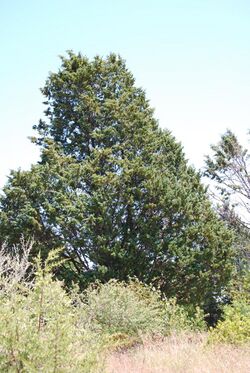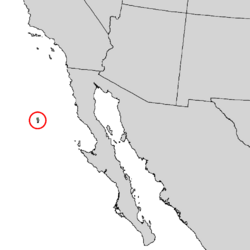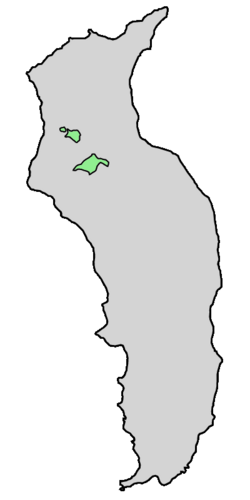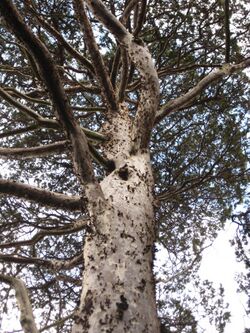Biology:Cupressus guadalupensis
| Cupressus guadalupensis | |
|---|---|

| |
| Scientific classification | |
| Kingdom: | Plantae |
| Clade: | Tracheophytes |
| Clade: | Gymnospermae |
| Division: | Pinophyta |
| Class: | Pinopsida |
| Order: | Cupressales |
| Family: | Cupressaceae |
| Genus: | Cupressus |
| Species: | C. guadalupensis
|
| Binomial name | |
| Cupressus guadalupensis S.Watson 1879
| |

| |
| Natural range | |

| |
| Guadalupe Island | |
| Synonyms[2] | |
| |
Cupressus guadalupensis, the Guadalupe cypress, is a species of cypress from Guadalupe Island in the Pacific Ocean off western North America.
Distribution
The Guadalupe cypress, Cupressus guadalupensis, is endemic to Mexico, found only on Guadalupe Island in the Pacific Ocean west of Baja California. It is found growing at altitudes of 800–1,280 metres (2,620–4,200 ft), in the island's recovering chaparral and woodlands habitats.
Cupressus guadalupensis has previously been listed as being the same species as Cupressus forbesii, which had been listed as a variety of C. guadalupensis in the past. Recent analysis, however, has placed C. forbesii as a separate, albeit closely related, species.[3]
Description
Cupressus guadalupensis is an evergreen conifer tree with a conic to ovoid-conic crown, variable in size, with mature trees reaching 10–20 metres (33–66 ft) tall. The foliage grows in dense sprays, dark green to gray-green in color. The leaves are scale-like, 2–5 mm long, and produced on rounded (not flattened) shoots.
The seed cones are spherical to oblong, 12–35 mm long, with 6 to 10 scales, green at first, maturing gray-brown to gray about 20–24 months after pollination. The cones remain closed for many years, only opening after the parent tree is killed in a wildfire, thereby allowing the seeds to colonise the bare ground exposed by the fire. The male cones are 3–5 mm long, and release pollen in February–March. A specimen survived at Cistus Nursery outside of Portland, OR during the winter of 2013-14, where temperatures went to -11.1111 Celsius.
Conservation - restoration
Guadalupe Island had a population of numerous but old and weak trees in 2000.[4] As a viable conifer woodland species they disappeared rapidly from the late 19th century onwards, as hordes of introduced feral goats ate the seedlings that germinated for over a century. One major subpopulation was destroyed entirely, and the isolated stands were nearly destroyed. Also, with the animals destroying most vegetation, and especially the island's cloud forest, the water table dropped, further jeopardizing the remaining two main subpopulations.[5]
The principal habitats were fenced in by 2001, and long-awaited removal of goats was effectively completed by 2005. The first young plants in 150 years or so are now able to grow and mature without being grazed away.[6] The present small population of 100 extant trees are vulnerable to long term viability. It appears this cypress is more vulnerable to drought than other island native plants, such as the Guadalupe variety of Monterey Pine (Pinus radiata var. binata), and so the population could decline further with future climate changes.[5] Habitat and watershed restoration and support projects are ongoing by Mexican conservation organization programs.
Cupressus guadalupensis is considered a vulnerable species by the IUCN.[7]
Footnotes
- ↑ Farjon, A. (2013). "Cupressus guadalupensis". IUCN Red List of Threatened Species 2013: e.T42220A2962608. doi:10.2305/IUCN.UK.2013-1.RLTS.T42220A2962608.en. https://www.iucnredlist.org/species/42220/2962608. Retrieved 12 November 2021.
- ↑ The Plant List Cupressus guadalupensis S.Watson
- ↑ Little, D. P. (2006). C guadalupensis is genetically most similar to C. stephensonii. Evolution and circumscription of the true Cypresses. Syst. Bot. 31 (3): 461-480.
- ↑ 200 according to CSG (2000), some 4000 according to León de la Luz et al. (2003). The cause(s) for this discrepancy are elusive.
- ↑ 5.0 5.1 León de la Luz et al. (2003)
- ↑ Junak et al. (2003)
- ↑ Farjon, A. (2005). Monograph of Cupressaceae and Sciadopitys. Royal Botanic Gardens, Kew. ISBN:1-84246-068-4
References
- Farjon, A. (2013). "Cupressus guadalupensis". IUCN Red List of Threatened Species 2013: e.T42220A2962608. doi:10.2305/IUCN.UK.2013-1.RLTS.T42220A2962608.en. https://www.iucnredlist.org/species/42220/2962608. Retrieved 12 November 2021.
- Junak, S.; Keitt, B.; Tershy, B.; Croll, D. & Sánchez, J.A. (2003): Recent conservation efforts and current status of the flora of Guadalupe Island, Baja California, Mexico. Presentation at Taller sobre la Restauración y Conservación de Isla Guadalupe ["Workshop on restoration and conservation of Guadalupe Island"]. Instituto Nacional de Ecología, November 13–14, 2003. HTML abstract.
- León de la Luz, José Luis; Rebman, Jon P. & Oberbauer, Thomas (2003): On the urgency of conservation on Guadalupe Island, Mexico: is it a lost paradise? Biodiversity and Conservation 12(5): 1073–1082. doi:10.1023/A:1022854211166 (HTML abstract)
- Little, D. P. (2006). Evolution and circumscription of the true Cypresses. Syst. Bot. 31 (3): 461-480.
External links
- Gymnosperm Database: C. guadalupensis var. guadalupensis
- Gymnosperm Database: C. guadalupensis var. forbesii
Wikidata ☰ Q1552597 entry
 |



